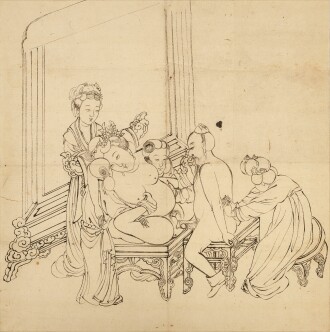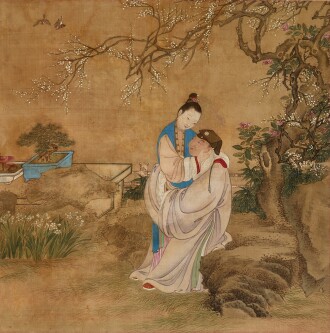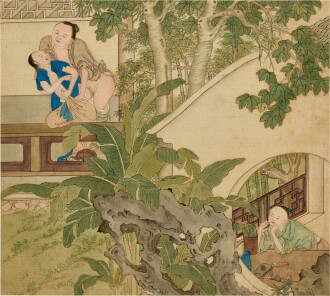The Important Chinese Art auction (29 April, Hong Kong) presents exquisite erotic paintings from the renowned private collection of Ferdinand Bertholet, works that offer a glimpse into the most intimate spaces of a vanished past, and an unparalleled view of sex in the ancient Middle Kingdom. In advance of this highly anticipated sale, Sotheby's takes a closer look at the erotic traditions of ancient China.
T he act of physical love was an important part of the natural order in ancient China. Not only was it the duty of both men and women to maintain the ancestral line, sexual harmony was also regarded as a way of promoting health and vigour.
Men of affluence and social standing enjoyed a high degree of sexual freedom, where forms of polygamy and concubinage had been recognised. Houses of pleasure catering to the predilections of an elite clientele flourished, and coupling of all sexualities and genders had been accepted to an extent. Such a climate stimulated the development of a courtesan subculture that would become celebrated by poets and scholars through the centuries. Erotic art would emerge as early as the Han dynasty (206 BC - 220 AD), an artform that would become widespread beginning the 10th century, coupled with the prosperity and growth of trading cities such as Suzhou and Hangzhou, and would reach its height during the late-Ming dynasty (1368-1644), where manifest expressions of erotic beauty remained a feature in literature or manuals.
Gardens of Pleasure – Erotic Art from the Bertholet Collection presents close to twenty works from the world's most important private collection of Chinese erotic art. These many treasures were brought together across a period of more than 40 years by Ferdinand M. Bertholet, an artist and passionate connoisseur who devoted decades of assiduous study to the subject.
“All of these pieces come from a world which no longer exists; they are the work of expert hands which created them with love and care, and each tells its own story. They express a poetry that enriches human existence and brings the past to life.”
Indeed, through these astonishing works, we as voyeurs gaze into the most intimate spaces of a bygone world. These pieces offer an unparalleled view of sex in the ancient Middle Kingdom, drawing us in with tantalising tales that arouse a sense of fascination or, perhaps, curiosity. These paintings shed light on all aspects of eroticism and intimacy, from explicit scenes of physical love to details of garden interiors, fashions, adornments, and domesticity. It also offers insight into historical concepts of fantasy, beauty, and eroticism, which stand in contrast to the modern mindset.
The garden, celebrated in literature as synonymous with pleasure and leisure, was an extravagance only the upper class could afford, and so remained, in a sense, a place of mystery to the masses. Gardens repeatedly feature as backgrounds to ravenous lovemaking, showcasing entwined branches and even suggestive rock sculptures that echo the lovers’ embrace. They present the ideal setting for an erotic fantasy, flirting along the boundaries of the internal and the external, in spaces that are semi-covered and semi-exposed; the open air entices the lovers to yield to their most carnal desires, and yet the thin screens do little to preclude the prying eyes of the voyeur – a role that we as an audience are invited to play. The myriad open windows and public pavilions that populate the scenes add to the risk of discovery, possibly heightening the exhibitionist impulse.
For the affluent lady, the garden was also one of the few places where it was permissible to have social interactions. Examples from literature illustrate the way the garden is regarded as a haven for the young women of well-to-do families. In the 18th century novel Dream of the Red Chamber (Hong Lou Meng), Jia Yuanchun would, upon her first return home since becoming an Imperial concubine, pay a visit to the celebrated Daguanyuan (Grand View Garden). The garden is an oasis presented in opposition to the stifling intrigues of the Imperial Palace. In the garden, our heroine finds a calm and elegant sanctuary from the outside world. So much of the novel’s action occurs within the place that it underscores the importance of the garden and its association with ideas of liberation and release.
Within Gardens of Pleasure – Erotic Art from the Bertholet Collection, the theme of physical love is interlinked to a greater ideal of freedom, with many of the garden pieces within the present collection projecting a certain Taoist flourish. These gardens may be regarded as the shared domain of both the masculine and feminine, thus liberated from strictures of hierarchy or dominance. In this sense, the union of lovemaking creates a perfect balance in the sex structure.
“Erotic art also reflects that ancient Chinese pursuit of harmony between man and nature,” according to Bertholet.
But perhaps the arresting power of nature is none the more potent than in the exquisite Gardens of Pleasure album formerly in the collection of C.T. Loo (lot 3656), a collection that particularly captured Bertholet’s imagination and attention. The set of eight paintings is not only precious for their meticulous execution done in the style of the late Zhe School – but also provides insight into the social intricacies of the late Ming dynasty.
Take for instance the piece Love Games in a Flowering Garden from the series. In the foreground is a couple in pre-coital embrace, identified by their adornments as a gentleman of social standing and a married lady. The figures are naturalistically rendered with facial features that conform to the traditional ideal of beauty. The silky drapery, exquisite jewellery and tasteful interior design undoubtedly indicate an imperial context. A closer look at clues in the background suggest something provocative about the pairing. Magnolias and peonies deceptively bloom side by side within the painting, which is a fallacy considering how they flower separately throughout the seasons. A blue Taihu rock elegantly balances the piece, and in a moment of insinuation, mirrors the pair’s copulating outlines. The paintings are further enhanced by rich symbolism throughout the album.
Only hands skilled enough to serve the court could have painted these charming scenes with such great detail. The album of eight paintings is most likely to have been produced by a court painter at the Qing Imperial Academy of the Kangxi Emperor. It stands among the finest examples of Chinese erotic artworks. A masterpiece of the highest calibre, Gardens of Pleasure is closely related to an album by an identified court artist Xu Wen (active 1690-1722, d. 1724) from Suzhou. She was summoned to court to participate in the painting project for the Kangxi Emperor’s 60th birthday.
Another highlight from the selection is a complete album of ten paintings with poems by the Suzhou master Wang Sheng (lot 3657), who was active from the late 16th to early 17th centuries and famous for his portrayals of elegant ladies and courtiers at the end of the Ming dynasty. Meticulously painted with fine-tipped brushes, the slender figures are set against backdrops of naturalistically rendered gardens or pavilions highlighted by occasional bold brushstrokes. Painted with technical finesse, the album presents couples engaging in different stages of intimacy, from gentle wooing in full attire to depictions of lovemaking in various positions and settings. The last leaf of the illustration depicts a homoerotic scene and bears the signature of the artist. It is extremely rare to find signed and dated Chinese erotic works, and this is possibly the earliest surviving example by an identifiable artist.
Chinese erotic painting has been largely dismissed or undervalued as an artform, according to art historian James Cahill, because many of the works that have survived to date are typically poor-quality examples of the genre. Gardens of Pleasure and Love Poems by Wang Sheng prove to be the rare counterarguments to that fact, as the presumed imperial commission by the Kangxi Emperor and existence of a reliable artist signature, respectively, attest to the highest level of artistry expressed in these two albums. Indeed the works that make up the renowned Bertholet Collection are famous for their extraordinary quality and importance, many of which have been exhibited at prestigious art institutions such as the Rietberg Museum in Zürich, the Cernuschi Museum in Paris, The Barbican Art Gallery in London, The Museum of Asian Arts in Berlin, The British Museum, and the Berkeley Art Museum.
Gardens of Pleasure – Erotic Art from the Bertholet Collection presents a rare opportunity to experience and acquire masterpieces of the genre, a field in which often more attention is paid to the prurient nature of the subject matter than in the artistic mastery and visual poetry of the works. These are treasures of a distant heritage that decades ago put Bertholet on a “quest that [brought] a new discovery every day.” Perhaps these paintings might also prompt us to see the world anew.













![View 1 of Lot 3659: Scenes from Xixiangji [Romance of the western chamber] Qing dynasty, early 19th century | 清十九世紀初 〈西廂記〉插畫 一冊十四幀 附詩文 設色紙本](https://sothebys-com.brightspotcdn.com/dims4/default/d62e8c4/2147483647/strip/true/crop/4285x5379+0+0/resize/300x376!/quality/90/?url=https%3A%2F%2Fsothebys-md.brightspotcdn.com%2Fe8%2Faa%2Fd1f5cbb54a81865c754bc120e051%2Fhk1209-c5nth-13-t2-v1.jpg)
![View 1 of Lot 3660: Scenes from Rou putuan [The carnal prayer mat] Qing dynasty, 18th century | 清十八世紀 〈肉蒲團〉插畫 一冊十一幀 設色紙本](https://sothebys-com.brightspotcdn.com/dims4/default/89142d3/2147483647/strip/true/crop/2000x1999+0+0/resize/330x330!/quality/90/?url=https%3A%2F%2Fsothebys-md.brightspotcdn.com%2Fb0%2Feb%2F06ab94aa41d594c9e05ba45b2993%2Fhk1209-c5ntj-2-t2-v1.jpg)







